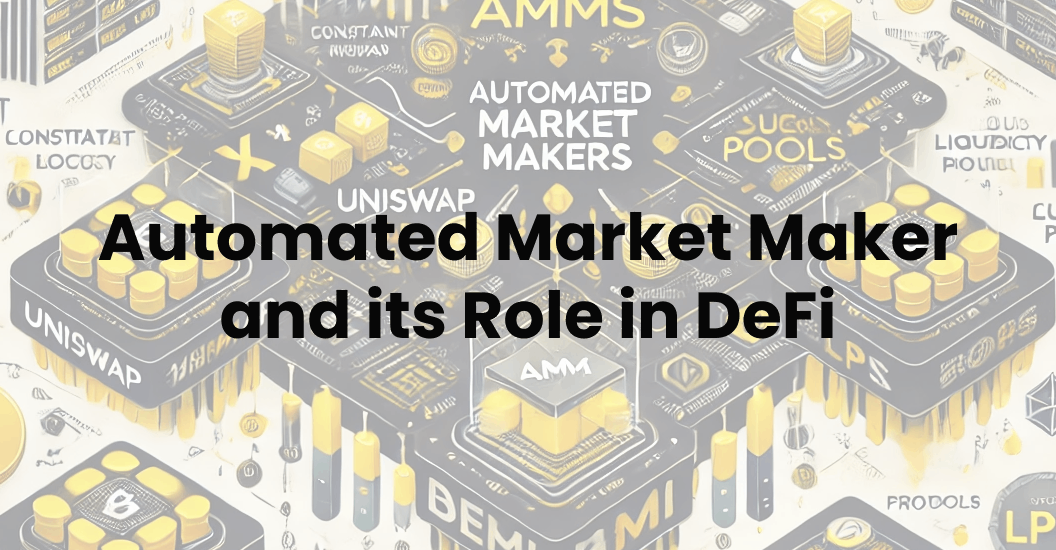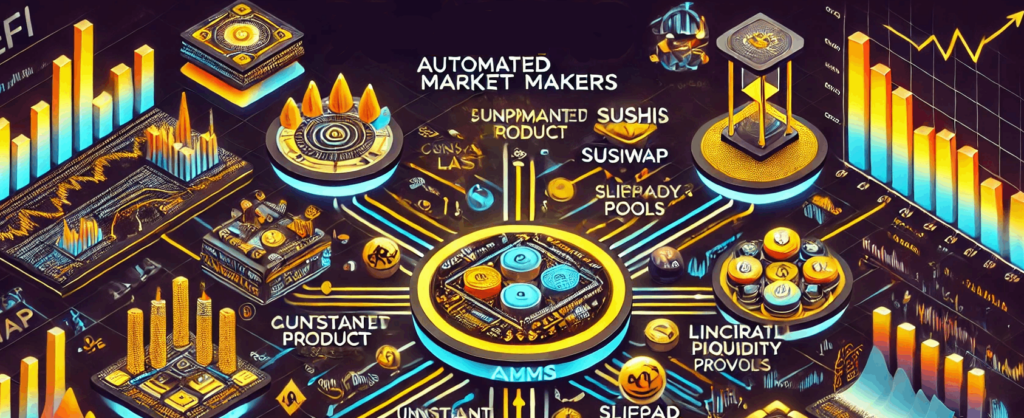- October 10, 2024
- Category: Cryptocurrency, Market Making

What is Automated Market Maker (AMM)?
Automated Market Makers are an innovative development within the scope of DeFi, entirely revolutionizing the way one handles liquidity and access to decentralized markets. While traditional financial markets operate with order books to organize and find a balance between buyers and sellers, Automated Market Maker operates on algorithms and liquidity pools that enable buying and selling. Such systems do not need any kind of central market maker; thus, DEX may function without intermediaries.
But instead of a vending machine having to rely on a store clerk to sell you a soda, the insides of the vending machine have an unlimited supply of sodas. Additionally, the price is dynamically computed by the device as a function of the amount of sodas taken or added. That’s roughly how an AMM works, dealing in cryptocurrency assets rather than sodas, with prices dictated by an algorithm, not a company that developed the device.
The Role of Automated Market Maker within DeFi
The core value proposition an AMM brings in DeFi is ensuring liquidity—once the liquidity exists, it is available to users for trading at any instance. This was considered one of the hardest tasks to enlist deep liquidity for decentralized exchanges because, without the central authority of the order book, matching buyers and sellers in real-time is tough. Sidestepping this issue, a common approach taken by AMMs is allowing anyone to become a liquidity provider by depositing tokens into liquidity pools. For example, if you were trading on the services offered by one of the forerunners in terms of AMM, Uniswap, you are trading against a liquidity pool holding reserves of at least two tokens, such as ETH and USDC. The AMM formula works by adjusting prices due to the supply of each token within that pool to enable instant execution of the trades, even in cases where there isn’t a buyer directly or a seller at that very moment. That’s a pretty radical difference from old-style order book exchanges, where liquidity can dry up in a heartbeat, particularly during times of high market volatility.
The Automated Market Maker Formula and Liquidity Pools
In the above formula, x and y are the reserves of any two assets in a liquidity pool, and k is a given constant that constrains the product of the two reserves to be the same before and after each trade. The more any one asset is traded, the more its price in the algorithm goes up relative to the other, thereby rebalancing the pool. This design ensures that the pool liquidity never “runs out,” although larger trades will incur more slippage—meaning the price will change more dramatically as the size of the trade goes up. Such a set balance of liquidity pools is what makes Automated Market Maker unique and a key constituent of the DeFi ecosystem.
How AMMs Work within DeFi?
The Constant Product Formula
At the center of any AMM is a mathematical formula driving liquidity and price discovery. The most commonly used model is that of the constant product formula, x * y = k. Here, x and y' stand for the quantity of two tokens in a liquidity pool, whilek` is some invariant that does not change as trades go through.
This formula gives the assurance that there will always be liquidity provided, even while the relative prices of the assets change according to their composition within the pool.
For example, let’s know that a liquidity pool exists for ETH and USDC. The pool is a whole, so when the amount of ETH in the pool is sold to somebody, its price rises. When more ETH is added to the pool—as someone sells—its price falls. This system of automatic self-balancing is how Automated Market Maker can have markets without order books or market makers: prices adjust automatically based on the supply and demand within the pool.
Liquidity Pools and Liquidity Providers (LPs)
Unlike traditional exchanges, which rely on an immediate buyer-seller order matching mechanism, AMM liquidity pools drive the process. A liquidity pool is essentially a pair of storages of two tokens maintained by their liquidity providers. In principle, anyone can be an LP by depositing an equal value of two underlying assets—for example, ETH-DAI—into the pool and thus receives a set of LP tokens, a pro-rata share of it.
Hence, liquidity providers form the most crucial part of the entire AMM ecosystem since they maintain constant liquidity in the pool by locking up their tokens. It also means traders are able to swap directly with the pool rather than wait for an order to be matched. Because this is the case, as a reward for providing liquidity to pools, LPs are given a portion of the trading fees generated on the platform. This means, for example, that on Uniswap, a 0.3% fee of every trade made within one’s pool is returned to the liquidity provider based on their share of the total pool.
Impermanent Loss: The Risk of Liquidity Providers
Accompanying this profit, of course, are risks of providing liquidity to an Automated Market Maker. Probably the most fussed-over risk in the market right now is impermanent loss. This is when the price of one or both of the assets in the pool significantly changes compared to when this liquidity was deposited. The value of a provider’s tokens inside the pool may be lower as the prices change than if they had just held on to the assets themselves.
The formula of an AMM will, for example, automatically reduce the amount of ETH in the pool and add USDC in case someone deposits equal amounts of ETH and USDC into a liquidity pool, and then the price of ETH suddenly skyrockets. If you withdraw these assets during a period of price fluctuation, you may get less ETH back than you deposited and can thus be considered to have lost some compared to holding the assets outright. This type of loss is considered “impermanent,” however since the loss disappears when token prices return to previous levels. In most cases, the trading fees gained by providing liquidity help offset the impermanent loss—so it’s a calculated risk that is very normal for many LPs to accept.
Key Automated Market Maker Platforms within DeFi
Uniswap, SushiSwap, and Balancer – Leading Platforms
There are now a few leaders in the AMM space, with each offering unique features to attract both liquidity providers and traders. Perhaps the most well-known today is Uniswap, operating entirely on a constant product formula; competitors have risen to the fore with similar models offering additional incentives to their liquidity providers through token rewards. Balancer stands out by allowing users to create more than two-token liquidity pools, with weighting adjustable, thus offering even greater flexibility.
Uniswap’s Dominance in AMM
The success of Uniswap as the default home of AMM may be due to its being the first fairly user-friendly and straightforward application to come out of DeFi. Today, Uniswap executes billions of dollars in trading volume every month, securing its place as one of the world’s largest decentralized exchanges. Liquidity providers play a very important role in ensuring trades happen instantly without the requirement for the buyer or seller to be online.
Risks and Challenges of AMMs
Impermanent Loss Revisited
As mentioned previously, one of the biggest problems affecting liquidity providers on AMMs is the impermanent loss-outcome related to the variation in the value of the assets in a liquidity pool. Providers might end up with fewer tokens than they have deposited if market prices move against them.
Price Slippage and Low Liquidity Pools
Another vulnerability of AMMs is when slippage occurs, mainly in low-liquidity pools. Very large trades could have immense effects on the prices of assets in the pool and lead to super bad trading results. Slippage gets even worse when there are volatile market conditions, and thus, everyone floods in to buy and sell assets.
Security Risks in Smart Contracts
AMMs rely heavily on smart contracts both for trading and the management of liquidity pools. Smart contracts themselves are also not perfect and may be exposed to bugs or hacks. Several poorly coded contracts have been exploited in the past, causing huge losses among their liquidity providers. Going forward, with continuous evolution, AMMs must ensure robust security measures and audits of smart contracts to avoid such vulnerabilities.

The Future of Automated Market Maker in DeFi
Innovations in AMM Design
New designs and features are constantly upgrading AMMs. The addition of concentrated liquidity in Uniswap’s v3 will enable liquidity providers to define the price ranges within which they would like to provide liquidity, further enhancing the features of capital efficiency and impermanent loss mitigation. Similarly, other initiatives have actually been working on hybrid models that combine aspects of AMMs with traditional order book systems in a competitive bid to create even better trading mechanisms.
Expanding the Ecosystem of DeFi
As DeFi grows, so will the demand for efficient, scalable AMM systems. With new decentralized projects and tokens coming online every quarter, the demand for liquidity solutions such as AMMs will remain the main course in this developing space. Moreover, once the world of traditional finance finally takes notice of the recent rapid expansion of DeFi projects, it is most probable that we will see even more integrations of AMM technology in mainstream financial products.
Predictions for the Role of AMMs
Going forward, AMMs are likely to remain a core building block in the DeFi ecosystem, creating the preconditions for liquidity and, therefore, decentralized trading. As the technology matures, we could even see the adoption of AMMs into a broader set of financial products by offering a decentralized alternative to meet the liquidity needs of small- and large-scale projects alike.
Final Thoughts on Automated Market Maker
By guaranteeing liquidity in a decentralized manner, Automated Market Makers have revolutionized DeFi. The innovation of using liquidity pools and mathematical formulas in decentralized systems has driven the rapid growth of DeFi, which intends to create a more inclusive financial system. This new technology is not without risks, though, since impermanent losses and slippage are potential threats, along with other security vulnerabilities that the technology must take very great care to handle. While it is the case that AMMs will continually evolve and improve, this means their use in DeFi will only grow further, providing solutions for decentralized liquidity markets that are more efficient, scalable, and secure. Indeed, the future for AMMs shines bright, with lots of room left for innovation and wider adoption across the DeFi space.
Add a comment
You must be logged in to post a comment.

